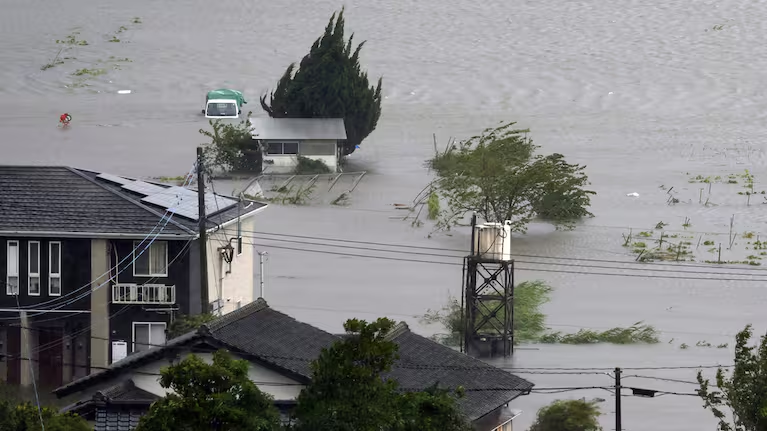Introduction: A Storm of Unprecedented Proportions
On August 29, 2024, Japan experienced a catastrophic weather event as Typhoon Shanshan struck with overwhelming force. This formidable typhoon brought torrential rains and powerful winds that devastated southern Japan, causing extensive damage and claiming at least three lives. As the storm continued its path up the archipelago, it triggered severe flooding, landslides, and widespread infrastructure damage, presenting a major challenge for emergency services and residents alike.

Landfall and Immediate Impact
Typhoon Shanshan’s Arrival and Early Effects
Typhoon Shanshan made its dramatic landfall on the southern island of Kyushu early on August 29. The storm’s arrival marked the beginning of a relentless assault on the region, with Miyazaki City facing some of the most severe impacts. The typhoon’s intense winds uprooted trees, overturned vehicles, and shattered windows, showcasing the ferocity of this natural disaster.
In Miyazaki prefecture, the rainfall was staggering—nearly 60 centimeters (approximately 2 feet) fell within a 24-hour period. This amount of rain significantly exceeded the average August rainfall, leading to swollen rivers and an elevated risk of flooding. The Japan Meteorological Agency (JMA) reported that such extreme weather conditions posed a serious threat of riverine floods and landslides.
Extent of Damage
The aftermath of Typhoon Shanshan was catastrophic. Streets in Miyazaki City were inundated with floodwaters, making roads impassable and disrupting daily life. Buildings suffered extensive damage, with shattered windows and collapsed rooftops adding to the chaos. Fallen trees and debris obstructed key roads, complicating rescue and recovery efforts.
Emergency Response and Rescue Operations
Coordinated Efforts to Assist Affected Areas
In response to the disaster, emergency services were swiftly mobilized. Rescue teams from local and national agencies worked around the clock to assist those affected by the storm. Efforts focused on reaching stranded individuals, providing medical aid, and evacuating those in danger. The Japanese government also set up temporary shelters for displaced residents, ensuring that they had access to essential supplies and services.
Challenges in the Aftermath
The scale of Typhoon Shanshan’s destruction posed significant challenges for recovery. The combination of flooding, wind damage, and infrastructure failure made it difficult for emergency responders to access affected areas. Power outages and disrupted communications further complicated rescue operations. Despite these challenges, the response efforts demonstrated the resilience and coordination of Japan’s emergency services.
Flooding and Landslide Risks
Flooding Across Affected Regions
The heavy rainfall from Typhoon Shanshan caused rivers to overflow, leading to severe flooding in several regions. Farmlands along the Yufu River in Oita prefecture were particularly hard-hit, with fields submerged under water. The flooding not only damaged crops but also threatened local ecosystems and infrastructure.
Increased Landslide Risks
The intense rainfall also increased the risk of landslides, especially in hilly and mountainous areas. The saturated soil conditions made slopes unstable, raising concerns about potential landslides that could further exacerbate the damage. Authorities issued warnings and conducted evacuations in vulnerable areas to mitigate the risk.
Global and Local Reactions
International Support and Solidarity
The impact of Typhoon Shanshan garnered international attention and support. Countries and organizations around the world extended their condolences and offered aid to Japan. International relief efforts included the provision of financial support, supplies, and technical assistance to aid in recovery and rebuilding.
National Resilience and Recovery Efforts
Within Japan, the focus has shifted to recovery and rebuilding. Communities have come together to support one another, and national and local authorities are working diligently to repair infrastructure and assist those affected. The resilience of the Japanese people is evident in their determination to recover from this devastating event.
Timeline of Events
- August 29, 2024: Typhoon Shanshan makes landfall on Kyushu, Japan. Heavy rain and strong winds cause widespread damage and flooding.
- August 30, 2024: Rescue operations continue as emergency services address the immediate needs of affected residents. Authorities issue flood and landslide warnings.
- August 31, 2024: Recovery efforts intensify with a focus on repairing infrastructure and restoring services. International aid and support are mobilized to assist Japan.
Expert Opinions
Dr. Hiroshi Nakamura, Meteorologist at the Japan Meteorological Agency:
“Typhoon Shanshan’s strength and the volume of rainfall it delivered were beyond what we typically experience in August. The resulting floods and damage are significant, and we are working to provide accurate and timely updates to help manage the situation.”
Yuki Takahashi, Disaster Management Expert:
“The response to Typhoon Shanshan has been robust, but the scale of the damage highlights the need for ongoing efforts in disaster preparedness and response. Rebuilding will be a lengthy process, and it’s crucial that we learn from this event to improve future resilience.”
Additional Sources:
For Regular News and Updates Follow – Sentinel eGazette
FAQs:
Q1: What caused Typhoon Shanshan’s severe impact on Japan?
Typhoon Shanshan’s severe impact was caused by its intense wind speeds and heavy rainfall. The storm unleashed nearly 60 cm of rain in some areas, leading to flooding and infrastructure damage.
Q2: How are local authorities responding to the aftermath of Typhoon Shanshan?
Local authorities are conducting rescue operations, providing temporary shelters, and working to restore damaged infrastructure. Emergency services are also focused on preventing further flooding and landslides.
Q3: What are the long-term effects of Typhoon Shanshan on the affected regions?
The long-term effects include extensive damage to homes and businesses, disruption of daily life, and potential long-term economic impacts. Recovery will involve rebuilding infrastructure and restoring normalcy.
Q4: How can people help those affected by Typhoon Shanshan?
People can help by donating to disaster relief organizations, participating in local volunteer efforts, and supporting recovery initiatives through government and non-profit channels.
Q5: What measures are being taken to prevent future damage from similar storms?
Measures include improving infrastructure resilience, enhancing early warning systems, and implementing better urban planning to manage flood risks and reduce damage from future storms.